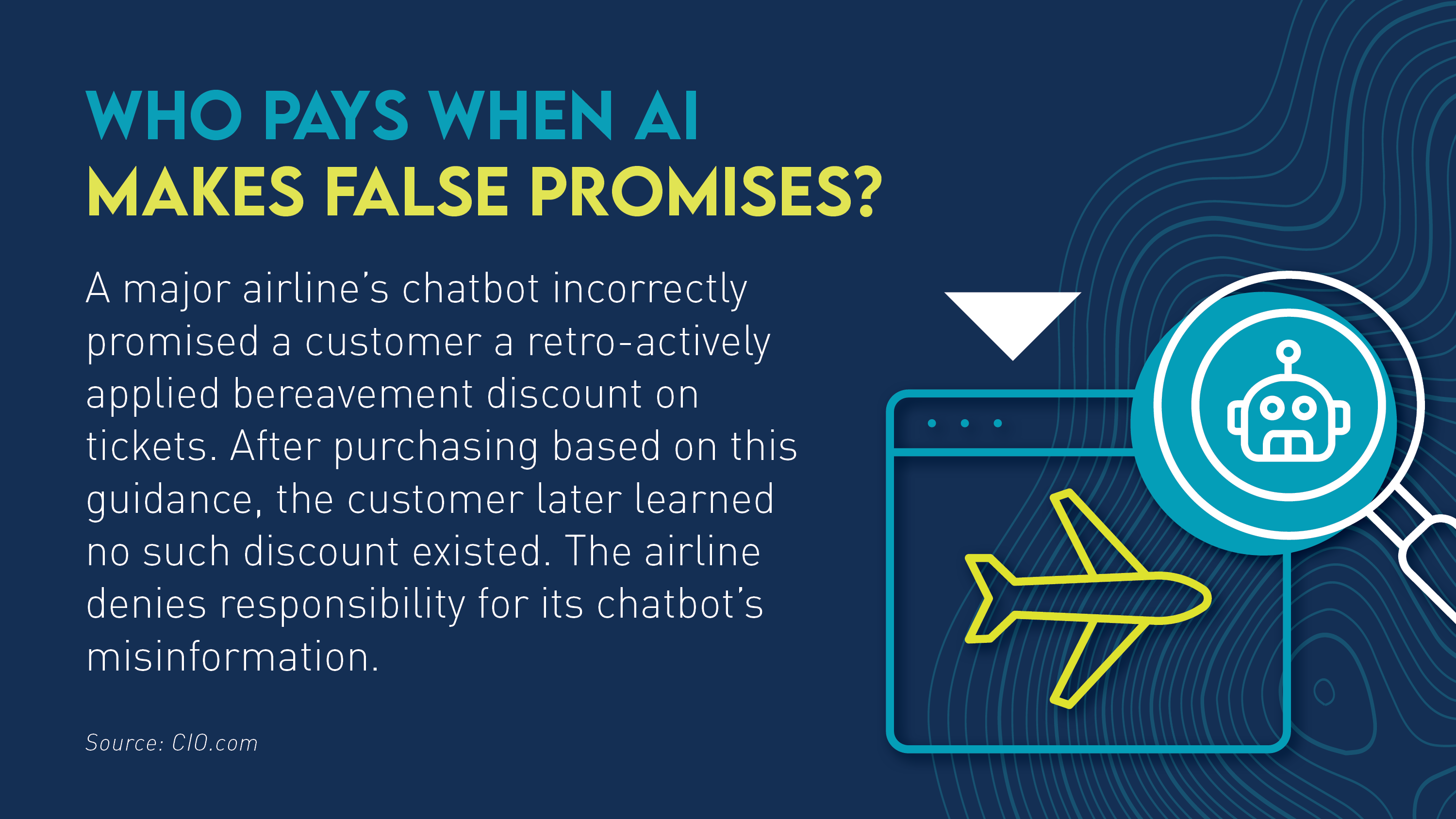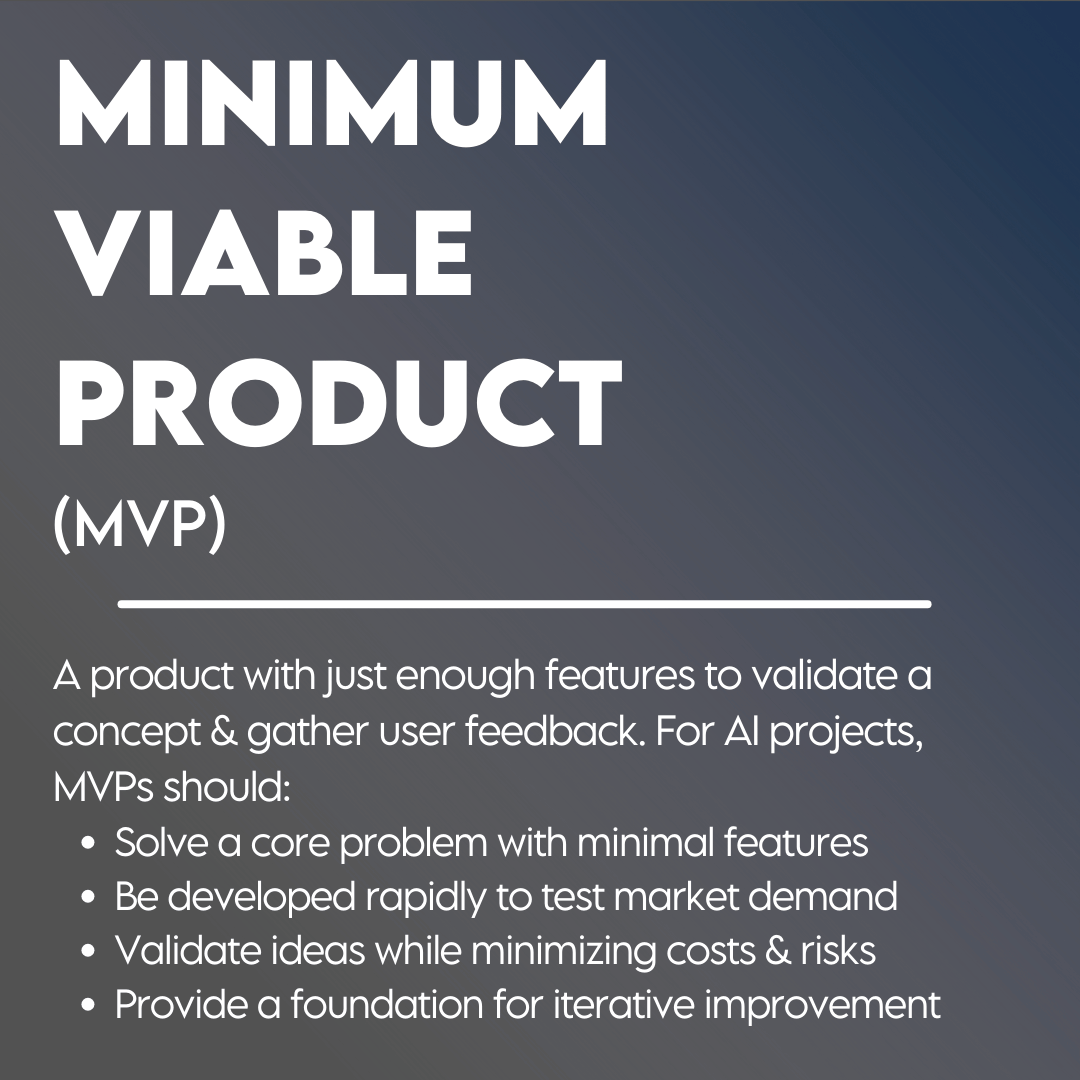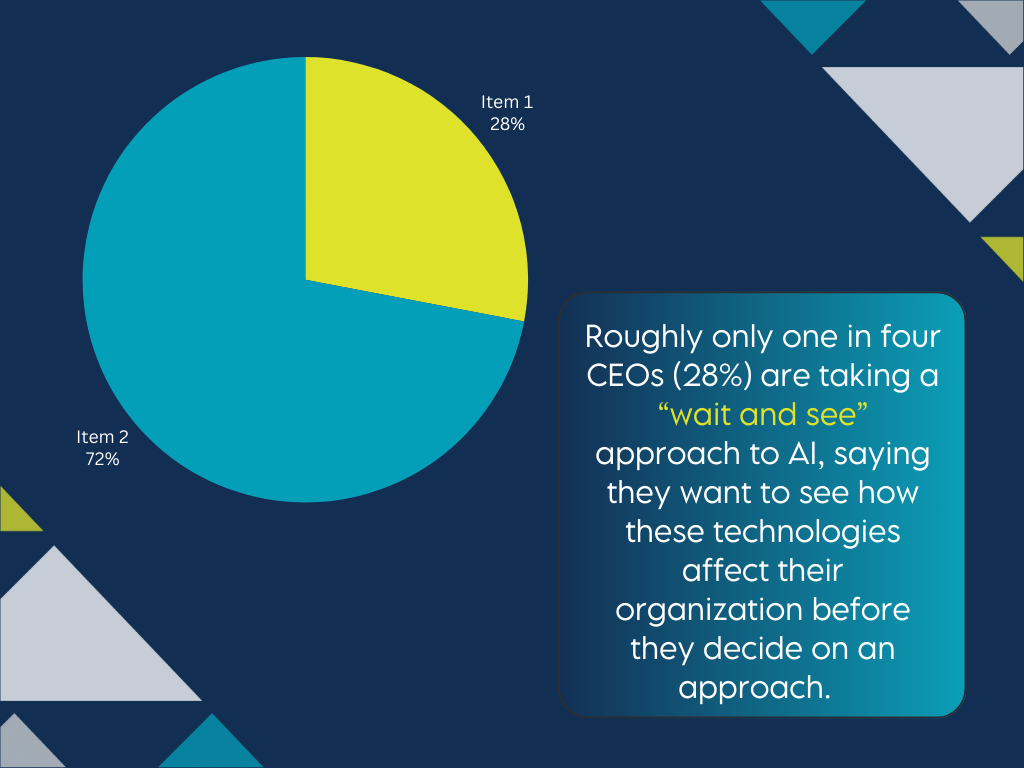.png)
The current dilemma. Not too fast. Not too slow. Value creation that’s “just right.” The price of moving too fast and getting it wrong, or moving too slow and missing the boat, couldn’t be higher. When it comes to adopting artificial intelligence (AI), too many may be overlooking the critical importance of finding the right pace.
Speed—or lack thereof—is not the sole culprit. It’s the prioritization of speed over impact, and a focus on the technology instead of the problem to be solved, that keeps the perfect pace just out of reach.
"In the rush to adopt AI, many organizations confuse motion with progress. The most successful implementations aren't necessarily the fastest – they're the ones where organizations have taken the time to build a strong foundation of data governance, change management, and cultural readiness. It's about being deliberate, not just quick." - Clara Sanchez, AI Center of Excellence Lead
In this two-part series, you’ll discover how pace plays a crucial role in achieving higher value AI deployments. Part one makes a compelling case for finding the right balance between speed and impact, and provides you with a tool to assess your current pace. In part two, you’ll get a pacesetting framework, designed to help you build long-term AI capabilities that deliver real value—not fall victim to hype-driven AI dependencies that ultimately disappoint.
AI challenges the concept of first-mover advantage
AI has captured an outsized piece of CEO mindshare. The last time we saw anything even close to the depth and extent of CEO interest was in 2012, when droves of CEOs started using iPads. That shift may seem quaint today, but it reflected a genuine watershed moment in how business leaders were embracing new technology at the time.
Back in 2012, first-mover advantage still held weight when it came to tech transformation. CEOs pushed their organizations out of a 30-year PC paradigm, fast and at scale, with a proclamation from high: “Put iPads everywhere.”
When AI entered the scene, CEOs logically approached its adoption in the same way they did the iPad: “Deploy AI everywhere, fast. Buy it all, let talent figure out how to make it work in their areas of expertise, and we’ll figure out how to generate enterprise-level value with it later.”
Yet AI changes everything. It changes how we transform. It changes our definitions of success, and our methods for measuring it.
AI is not an iPad. It’s time to stop approaching its adoption like it is.
Prioritizing speed over impact introduces risk as outsized as AI itself
The transformative promise of AI is worthy of the hype. AI-powered capabilities have the potential to accelerate and optimize everything we do.
But AI’s potential to deliver value at speed has been conflated with the need to adopt it at speed. In fact, the very opposite might be true.
25 percent of leaders say they moved too fast with AI, a sentiment likely fueled by the fact that only 47 percent of companies experimenting with AI are seeing tangible value.
Modern technology, like iPads, proved the value of the first-mover advantage. But with AI, the risks of moving too fast and getting it wrong are compounded in ways that only AI can orchestrate. These risks become a self-fulfilling prophesy, a flywheel of exponential factors that exacerbate impact—good and bad.
Companies are literally racing toward these four AI-sized risks.
Let’s look at the risks of mismanaged pace from the viewpoint of a common AI objective: Take out costs by replacing human functions with AI which have an impact on ROI, external & internal stakeholders, and performance.
32 percent of leaders are prioritizing customer service automation, while 31 percent are focusing on employee self-service automation.
ROI: Companies are throwing money at AI without investing in the elements it depends on for value creation.
Today, the cost of developing and training an AI model capable of replacing human workers outweighs potential savings for most tasks.
That’s not to say the cost/benefit ratio isn’t rapidly shifting, but today the hope of cutting headcount with AI must be strategically balanced with investments in its complex and costly enablers:
- Collective knowledge: All companies have data. Converting it into collective knowledge—the guiding blueprint
 that turns raw facts into insightful, actional insights—requires investing in robust knowledge management practices. Hint: Your “system of record” isn’t enough.
that turns raw facts into insightful, actional insights—requires investing in robust knowledge management practices. Hint: Your “system of record” isn’t enough. - AI Governance: AI governance isn’t just fancy data governance. Organizations must invest in AI governance practices and professionals that are robust and adaptable.
- Technology: Your existing tech architecture can be a critical enabler of AI value. It can also compound technical debt, promote functional and data silos, and restrict your computational power. Your fate depends on your ability to comprehensively connect your current tech assets to an AI value-creation journey in the short-, medium-, and long-term.
- Roles: AI will require more role changes than any other technology since the worldwide web went mainstream in the early 90s.
- Processes: It’s not about just doing the same things faster. Today’s processes must be reinvented to maximize and unleash the potential of AI-enabled tools.
Even as nearly half of all AI leaders admit to an inability to estimate or demonstrate the value of AI-related technology, Gartner predicts that "AI software spending will surge to $297.9 billion by 2027, up from $124 billion in 2022."
External reputational damage: Customer-facing functions have been among the first to be replaced by AI, and experience has taken a hit. 
This year, companies poured their hope and capital into AI-enabled solutions that promised experiences that are intuitive, predictive, and seamless.
So why have customer experiences gotten worse?
A June 2024 study revealed that a mere seven percent of customers say their service interactions improved over the last year, while 55 percent say their experiences worsened. But it’s more than just poor experiences—in highly regulated industries the risk of deploying AI without impact takes damage to new heights. Systems struggling to capture the nuances of customer interactions, or other data sets, are leading to:
- Hallucinating chatbots that provide inaccurate or misleading information
- Compliance violations for industries where context is crucial
- Decision-making breakdowns when institutional knowledge is needed
- Reputational damage that compounds with each automated mistake
It may be bad news for companies planning to deploy any of the more than one billion AI agents expected to be in service by the end of 2025. But the solution isn't to slow AI adoption—it's to ensure your AI systems can access and apply your organization's collective knowledge while maintaining compliance guardrails. Without this foundation, even the most sophisticated AI will fail to deliver on its promise.
A June 2024 report issued by the Homeland Security and Government Affairs Committee loudly raised a red flag, noting that existing regulation “insufficiently addresses” how hedge funds are already using AI. The report warned that there are “no regulations or requirements” mandating “when and whether a human must be involved in decision making, including related to trading decisions.”
Internal loss of trust: Employees feel like AI targets, but companies need AI evangelists.
A slew of recent high-profile labor disputes should give all leaders a taste for the mounting frustration and fear gathering within their workforce.
Most workers believe AI will affect their job. Eighty-five percent of workers say AI will impact their job in the next two to three years, with remote workers and younger employees most convinced AI will replace at least some of their functions.
Leaders should hang on, because that frustration and fear can worsen the more their workers engage with AI, directly demonstrating the risk of deploying AI the old way.
By favoring speed in deploying AI over things like governance, workforce reskilling, and change management, leaders put employee confidence and trust on the line. A sentiment of “You’re going to replace me with this?” can tear through an organization with the destructive force of a hurricane.
"Success with AI isn't about how fast you can deploy it – it's about how well you can integrate it into your organization's DNA." - Clara Sanchez, AI Center of Excellence Lead
Measuring success: KPIs and measurement practices based on the “old way” could be setting AI up for failure.
Minimum Viable Products (MVPs ) are often used to quickly validate AI concepts and gain early insights. However, when MVPs fail to meet expectations or deliver tangible value, it can lead to disappointment.
) are often used to quickly validate AI concepts and gain early insights. However, when MVPs fail to meet expectations or deliver tangible value, it can lead to disappointment.
Moreover, many organizations may not even be measuring the right things. Digital transformation’s “old way” calls for tracking technical metrics, things like precision, recall, and lift, all of which are woefully insufficient when it comes to AI. These metrics only account for the technical performance of a tool, not its impact.
But measuring for impact is complicated, and it demands operational and cultural alignment—something companies prioritizing speed over integrity are likely lacking.
96 percent of C-suite executives expected AI to boost productivity, however 77 percent of their employees using AI say it has added to their workload and created challenges in achieving the expected productivity gains.
Take a first step toward AI-generated value by assessing how well you’re balancing speed with impact.
While 25 percent of leaders acknowledge they moved too fast with AI, we think that number is likely much higher.
So how do you know if you’re on pace for AI value? Ask yourself these five questions:
- Are your MVPs delivering the value you expected? If yes, congrats. No? Keep reading.
- Are you deploying AI with a business-as-usual change strategy? If so, it’s time to reconsider your approach. Implementing AI in a siloed manner, without involving your C-Suite leadership, may hinder your ability to capture its full value potential. To ensure a successful AI transformation, ask yourself: How can we involve key stakeholders across the organization? What steps can we take to align our AI initiatives with our overall business strategy? By addressing these questions and adopting a holistic approach, you’ll be better positioned to maximize the benefits of AI for your organization.
- Can you point to an articulated plan, and is it continuously guiding the work? Do you know where you’ll end up? One client told North Highland they knew their pace of AI deployment was off when, along the way, some of their core principles became “optional.” The mandate from the top was “go quick” over “go with impact”: The company turned to North Highland after it became apparent that they were going nowhere fast.
- Are your people confused about objectives, processes, and priorities? It’s OK if your people don’t understand how your AI solutions work, but they should understand why they’re being deployed and their role in making them create value.
- Are you prioritizing the expected value or the solution itself? A “deploy AI everywhere” approach misses the point—and puts entire organizations at risk in unprecedented ways. If your AI solutions aren’t the answer to questions of “what problems do we want to solve, what value are we creating, and why?”, you’re going too fast.
Here's the great thing about pace: It’s something you can control.
A balanced pace—not too fast, not too slow—is essential for creating real value with AI. The good news? It's not too late to adjust your pace and set your organization on a path toward sustainable AI value creation.
In part two of this series, we'll share our recommended methodology for finding and maintaining the right pace for your organization. You'll discover how to build lasting AI capabilities that deliver measurable value—instead of falling victim to hype-driven dependencies that drain resources and disappoint. We'll show you how to move forward with both speed and impact, turning AI from a source of anxiety into a driver of sustainable competitive advantage.
The stakes are high, but so is the potential. The organizations that will succeed with AI aren't necessarily the fastest movers—they're the ones that move with purpose, precision, and a clear understanding of where they're going.
Gartner, Forecast Analysis: AI Software Market by Vertical Industry, 2023-2027, By Alys Woodward, James Ingham, et al…., 27 March 2024.
GARTNER is a registered trademark and service mark of Gartner, Inc. and/or its affiliates in the U.S. and internationally and is used herein with permission. All rights reserved.
Connected Content


.jpg9157.webp?itok=dVlauYF4)

2a6b.jpg?itok=4MSoMV8M)

